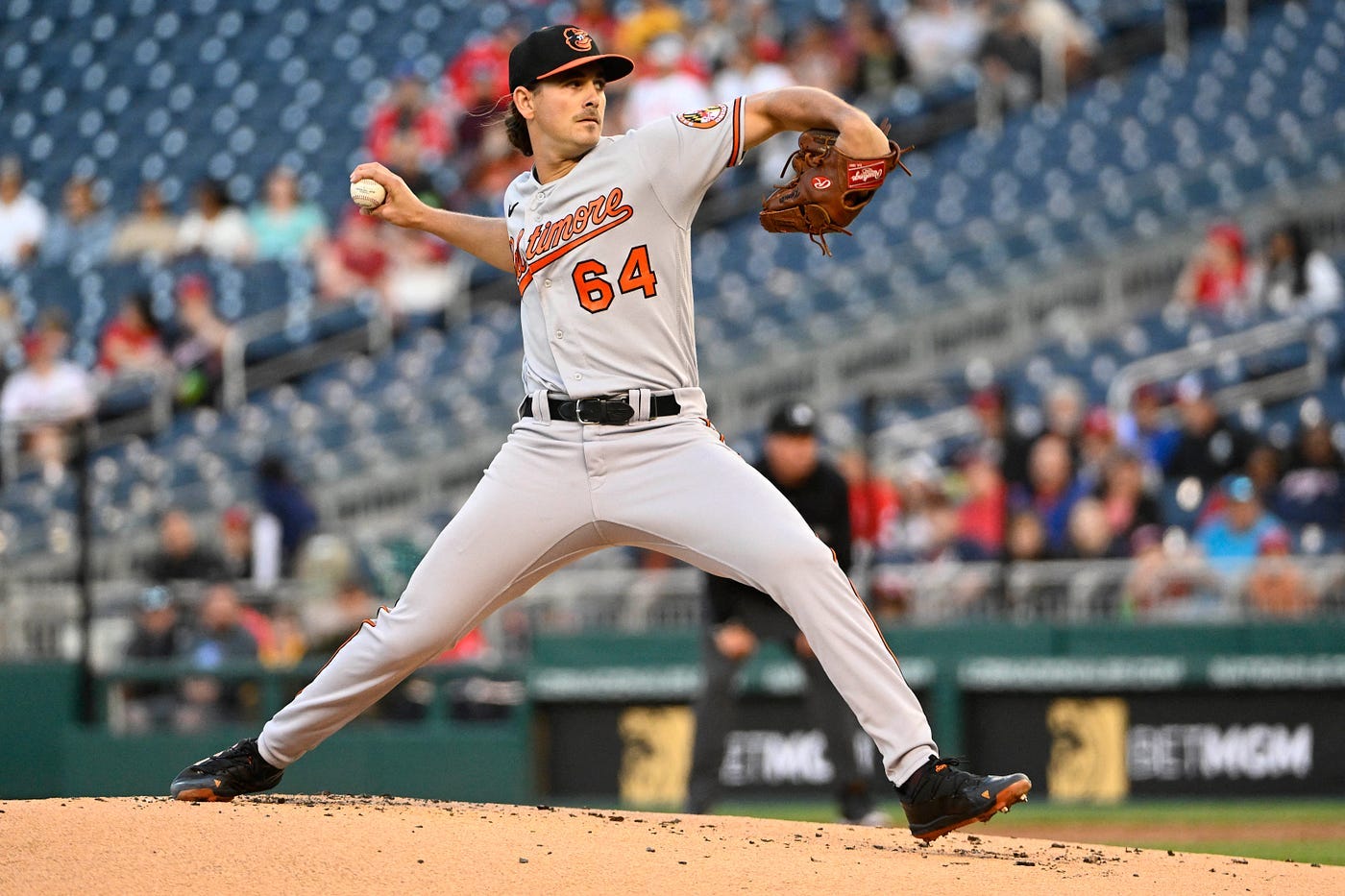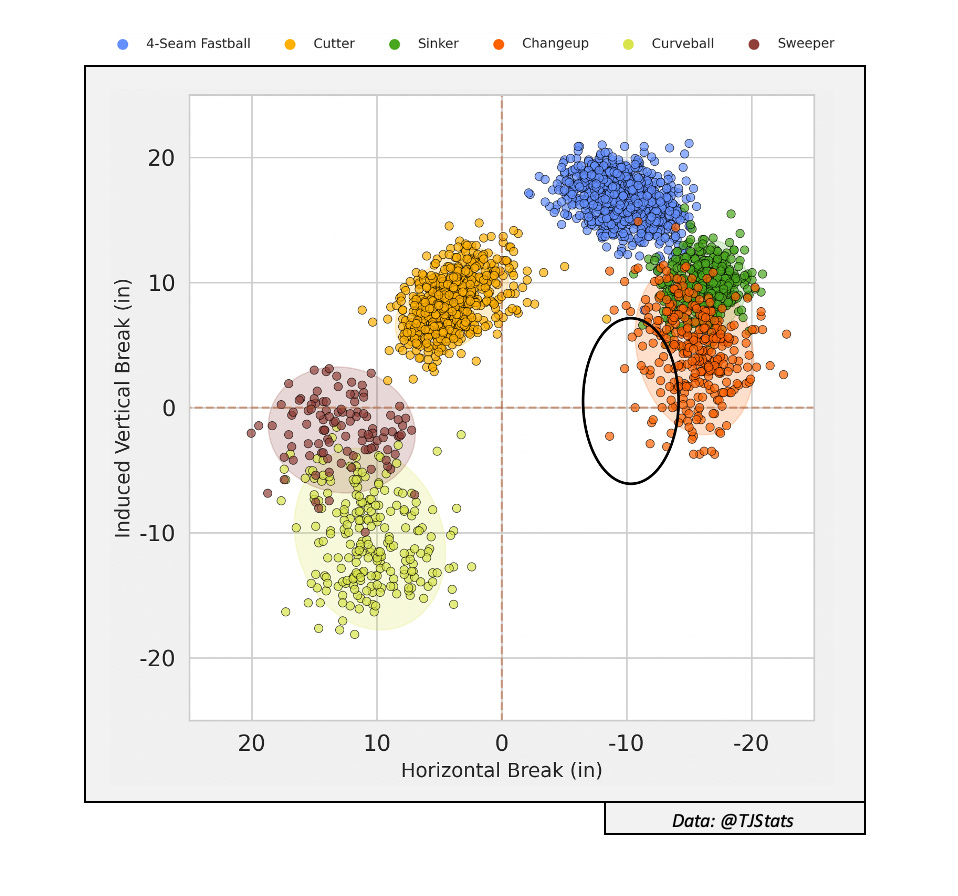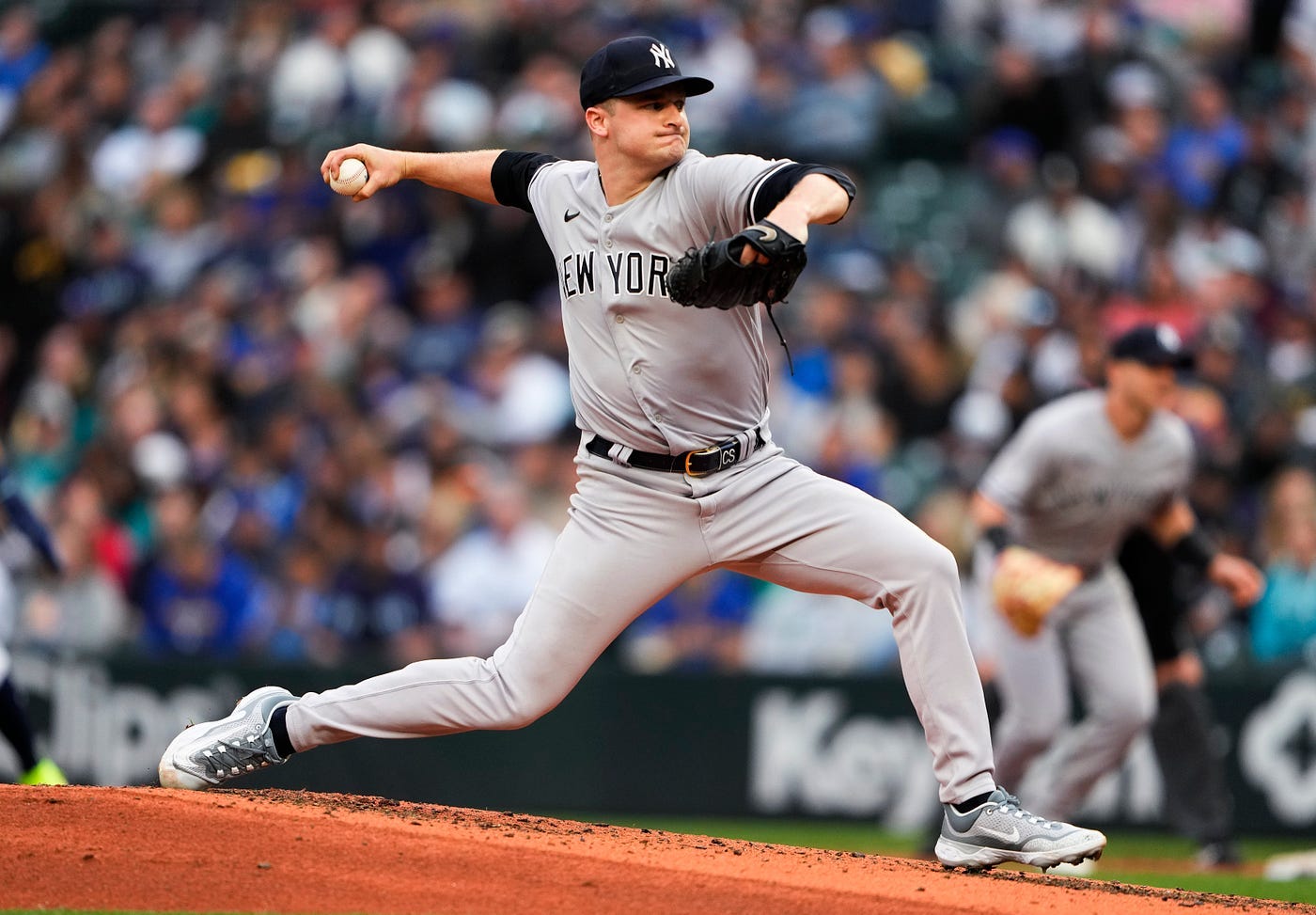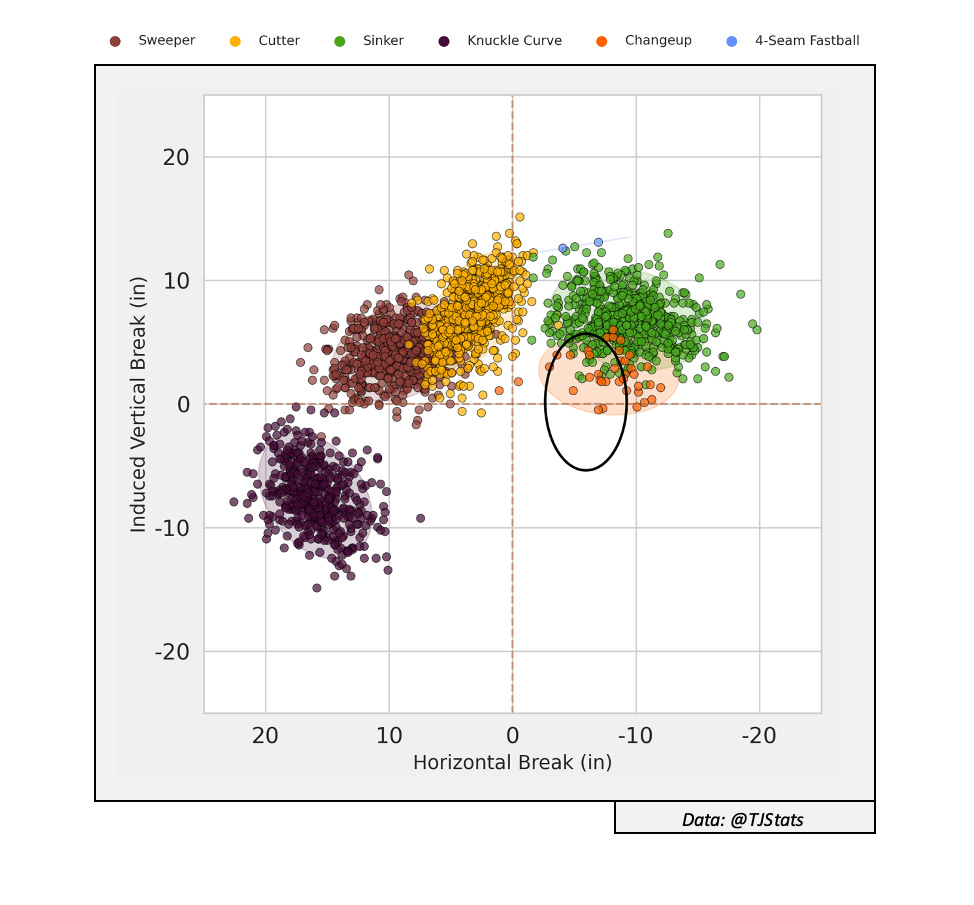The Next Pitching Revolution: Why The Splitter Is Poised For A Comeback
(9/8/23) The Untapped Potential of the Splitter in Modern Baseball's Pitching Landscape.
Originally published on Medium on September 8, 2023.
With significant advancements made in pitch tracking technology over the past few seasons, the landscape for Major League Baseball pitchers has been changed forever as organizations have more knowledge and insight than ever into which characteristics make particular pitches effective. With use of pitch modeling metrics, such as Stuff+, organizations are able to quantify how good a pitch is solely based on its characteristics, and use it as a blueprint on how to improve an individual pitcher’s arsenal. Improvements in pitch tracking technology has also allowed for analysts to analyze how well specific pitch types are performing as a whole, potentially revealing a market inefficiency if a particular pitch has seen excellent results despite relatively little usage. Given its superior movement profile and the better results it yields compared to its off-speed counterpart, the Changeup, I believe the Splitter is an underutilized pitch poised to experience a renaissance in the near-future.
One of the biggest developments of the 2023 Major League Baseball season has been the increased usage of the Sweeper across the league. First coined “the Dodgers Slider” in 2021, the Sweeper is a similar pitch to a Slider, however the pitch is able to achieve more horizontal movement (without an increase in “drop”/vertical movement) than the typical Slider due to seam effects, such as seam-shifted wake. Pitchers exhibiting supination bias are generally better equipped to incorporate a Sweeper into their pitch arsenal. On average, the Sweeper generates as many Whiffs as a Slider, but induces a lower-quality of contact due to its unique movement profile.
Given that Sweepers have produced a lower wOBA than Sliders over the past three seasons, more pitchers have added Sweepers to their arsenals over the past year. Due to so many pitchers adding Sweepers to their arsenals this season (increasing overall Slider usage as a whole), hitters have been making the appropriate adjustments and have improved against all types of Sliders this season.
With hitters making adjustments against pitches with glove-side movement, such as Sliders and Sweepers, I believe that pitches with arm-side movement are about to see a renaissance in usage and effectiveness. Similar to how Sweepers have been proven to be more productive pitches than traditional Sliders, Splitters have outperformed Changeups over the past three seasons and could see a resurgence in the future if more pitchers add them to their pitch arsenal.
Similar to Sweepers, pitchers who exhibit supination bias are generally better equipped to incorporate a Splitter into their pitch arsenal. Supinators are ideal candidates to add a Splitter to their arsenal because they are generally unable to create the side-spin necessary to produce an exceptional Changeup like pronators are able to. By utilizing a split-finger grip, natural supinators are able to achieve more vertical drop and produce an overall better off-speed offering with a Splitter than trying to create side-spin on a Changeup by forcing pronation against their natural supination bias.
Despite these advantages of supinators utilizing Splitters over Changeups, Major League Baseball has not seen a major increase in Splitter usage in recent seasons. This can potentially be attributed to two reasons. First, adding a new pitch to a pitch arsenal is difficult, and a lot of training goes into pitch design sessions beyond simply identifying a pitch that a pitcher should add to improve their arsenal. It is entirely possible that pitchers and pitching coaches as a whole have simply placed more emphasis in recent seasons on improving Sliders than improving Changeups given the larger “Sweeper trend” that has been occurring around the sport. Second, the popular notion that Splitters are more likely to cause injuries than other pitches has circulated since the 1990’s, and might be to blame for the lack of Splitter usage compared to other pitches. While injury management is very important especially for professional pitchers, there is inherently a lot of injury risk with throwing a baseball with velocity and there is little evidence in the amount of public research available that suggests that Splitters are exceptionally “dangerous” to throw compared to other pitches.
Given these factors, I believe that pitchers who are natural supinators, have had suboptimal results with their Changeups, and/or have underwhelming platoon splits should develop a Splitter to either add to their pitch arsenal or replace their existing Changeup. Not only does data from recent seasons indicate that Splitters are more effective than Changeups with these particular pitchers, but adding a Splitter can also give a pitcher a competitive advantage over their peers due to the current low usage of the pitch around the league. One pitcher that has replaced his Changeup with a Splitter in recent seasons and has seen success is Joe Ryan. A pitcher with supination bias, Ryan re-worked his pitch arsenal over the offseason to surround his very good Four Seamer with a Sweeper and a Splitter, which has led Ryan to more success this season.
Given that they meet the underlying requirements to effectively utilize the offering, more pitchers should follow Joe Ryan’s lead and develop a Splitter to replace their Changeup and enhance the overall performance of their off-speed offering. The following three pitchers are ideal candidates to add a Splitter to their pitch arsenal in the near-future:
Bryan Woo (Seattle Mariners):
One pitcher that is an ideal candidate to add a Splitter to their pitch arsenal next season is Bryan Woo of the Seattle Mariners. Since making his Major League debut on June 3rd, Woo has impressed observers with outstanding performance from his Four Seamer, Cutter, and Sinker. Similar to Joe Ryan, Woo has an average Four Seamer according to Stuff+ (97), but is able to generate Whiffs with the pitch at the top of the zone due to the flat vertical approach angle he generates with the offering.
Woo is an ideal candidate to develop a Splitter in particular because of the extreme platoon splits he has generated this season. While his Fastball heavy approach has worked well against right-handed hitters this season, he has had considerable difficulty getting left-handed hitters out during his stint in the Majors this season.
As shown by the table above, Woo has been simply dominant against right-handed hitter this season, producing an impressive .199 wOBA, 25.0% K-BB, and a 2.36 FIP. Against left-handed hitting, Woo has performed considerably below-average, generating a .415 wOBA, 5.0% K-BB, and a 6.48 FIP. Given these extreme platoon splits, Bryan Woo seems like a natural candidate to replace his existing Changeup with a Splitter, in order to have a pitch in his arsenal that can be utilized to generate more swing-and-miss against left-handed hitters.
Woo has allowed a lot of hard contact on his Changeup this season, with left-handed hitters producing a .476 xwOBAcon against the offering this season. As shown by the pitch movement plot above, adding a Splitter (black circle) will not only create more downward vertical movement than his current Changeup, but will also create more movement separation with his Sinker than will hopefully allow Woo to generate more swing-and-miss with the offering. Woo’s Changeup currently has an average velocity of 89.6 MPH, so it can be expected that the Splitter will average at least 87 MPH.
Adding a Splitter to his pitch arsenal will give Bryan Woo an effective off-speed offering to utilize with two strikes, which will help reduce the extreme platoon splits that are currently holding Woo back from reaching his full potential.
Dean Kremer (Baltimore Orioles):
Another pitcher that is an ideal candidate to add a Splitter to his pitch arsenal next season is Dean Kremer of the Baltimore Orioles. Acquired by Baltimore as part of the prospect package for Manny Machado in 2018, Kremer has performed as a back-of-the-rotation starter at the Major League level, producing a 4.07 ERA (4.42 SIERA), and 14.3% K-BB in 28 starts this season. Similar to Woo, Kremer has run into some platoon difficulties this season, performing much better against right-handed hitters than left-handed hitters.
As shown by the table above, Kremer has performed like a solid back-of-the-rotation rotation starter against right-handed pitching, producing a .294 wOBA, 17.5% K-BB, and 3.93 FIP. Against left-handed pitching, Kremer has run into more difficulties, producing a .351 wOBA, 10.3% K-BB, and 5.63 FIP. As a pitcher that has exhibited supination bias, adding a Splitter to his pitch arsenal may be the best course of action to generate more Whiffs and Chases against left-handed hitters.
As shown by the table above, the addition of the Splitter (black circle) will create more downward vertical movement than his current Changeup, and create more movement separation from his current Sinker. Kremer’s Changeup currently has an average velocity of 85.2 MPH, so his Splitter can be expected to average at least 84 MPH. Adding a Splitter to his pitch arsenal will improve Kremer’s production by generating more swing-and-miss against left-handed hitting, potentially solidifying his role in the back-end of the Baltimore Orioles rotation for seasons to come.
Clarke Schmidt (New York Yankees):
Another pitcher that is an ideal candidate to add a Splitter to their pitch arsenal next season is Clarke Schmidt of the New York Yankees. Clarke Schmidt has made many adjustments to his pitch mix in recent years, adding a Sweeper and Cutter to his arsenal over the past two seasons. The addition of the Sweeper to his pitch arsenal has helped Schmidt become very effective against right-handed hitters, however the addition of the Cutter has yet to minimize Schmidt’s difficulties against left-handed hitters.
Schmidt has been dominant against right-handed hitters this season, producing a .283 wOBA, 21.4% K-BB, and 3.79 FIP. Against left-handed hitters, Clarke has continued to struggle, producing a .381 wOBA, 11.1% K-BB, and 4.80 FIP. Perhaps tinkering with a Splitter to create a better off-speed offering might help to neutralize these platoon splits?
As shown by the table above, Schmidt is certainly a unique candidate to add a Splitter to his arsenal compared to the prior two candidates that I analyzed. While the Splitter (black circle) would generate more downward vertical movement than Schmidt’s current Changeup, Schmidt does not generate much movement separation with the pitches in his pitch arsenal. While this makes Schmidt a unique candidate to add a Splitter to his pitch arsenal, this would not be unprecedented. Alex Cobb of the San Francisco Giants has achieved success by primarily utilizing a Sinker and Splitter combination, with both pitches exhibiting similar movement profiles. I believe that at least tinkering with a Splitter is a good course of action for Schmidt, given the poor results he has experienced with his Changeup this season. Schmidt has averaged 89.6 MPH on his Changeup this season, so his Splitter can be expected to average at least 87.5 MPH. Adding a Splitter to his pitch arsenal will give Clarke Schmidt an effective offering to utilize against left-handed hitting, and has the potential to raise Schmidt’s overall ceiling as a starting pitcher moving forward.
Concluding Thoughts:
Given its superior movement profile and the better results it yields compared to its off-speed counterpart, the Changeup, I believe the Splitter is an underutilized pitch poised to experience a renaissance in the near-future. Splitters produce a lower wOBA, generate more Whiffs, and induce more ground balls than Changeups, which makes the Splitter a good pitch for a pitcher with supination bias to add to their arsenal if they are having difficulties against hitters of the opposite handedness. By embracing the untapped potential of the Splitter, pitchers can not only enhance their individual arsenals but potentially take part in a renaissance of Splitter usage that may alter the pitching landscape across Major League Baseball.
Follow @MLBDailyStats_ on X (Twitter) for more in-depth MLB analysis. Statistics provided by Baseball Savant, FanGraphs, Alex Chamberlain’s Pitch Leaderboard, and TJ Stats on Patreon.
















